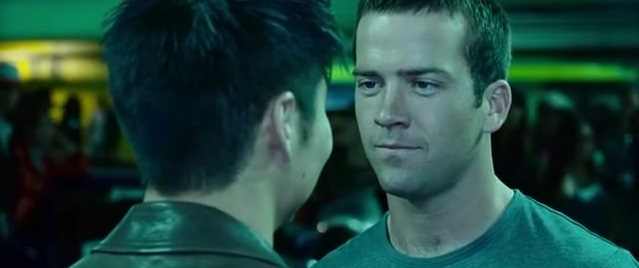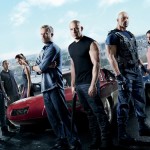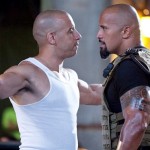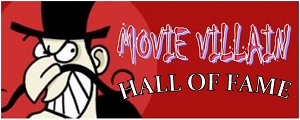
In the intro to part one of this retrospective, I stated that the Fast & Furious franchise is bizarre. The series' third entry is why …
THE FAST AND THE FURIOUS: TOKYO DRIFT (2006)
This is the point where the franchise probably should have starting cranking out direct-to-DVD entries. This is where everyone expected the F&F movies to begin jumping sharks. Save for future Cinematallica headmaster and fellow podcast Cult Spark Podcast jockey, Tim Kelly, I don't know of anyone who thinks 2 Fast 2 Furious is one of the better films in the franchise. Tokyo Drift should have been the beginning of the end.
 And yet it's not. Somehow, even as lackluster as the response was, the series endured.
And yet it's not. Somehow, even as lackluster as the response was, the series endured.
Even more bizarre, as much as people shunned it, Tokyo Drift ended up being one of the best movies in the franchise.
I can understand why people shunned it. That's what happens when you have a setting that's the precise opposite of the sun-baked locales of the first two, leads who no one has any sort of attachment to and a style of racing in drifting that the majority of Americans aren't all that familiar with. Heck, even I initially turned my nose up. I mean, who really expects a street racing movie with Lucas Black as the lead to really be any good?
So what makes this the best? Well, for one, it's got the best pure car action in the entire F&F run. Yes, even better than Fast Five. Five never really focused on racing at all. By that point the series had evolved into something entirely different, so quarter-mile or drifting runs weren't really going to be a focus. So purely in terms of watching guys pull of feats of pure racing finesse, Tokyo Drift reigns as champion.
Drifting is such a dynamic and exciting style and could basically be considered a "cinematic" form of racing. Director Justin Lin seems to understand this and does a tremendous job of shooting these races and chases for maximum effect. There's a scene at the end of the second act that stands as hands-down one of the best car chases in the last decade. Not bad for a director attempting his first real action movie, especially when you realize just how well Lin maintains the scene's momentum and sense of geography amid a flurry of flashy cars slipping and sliding across the screen and through heavy traffic. There's a bit too much reliance on CGI cars in the film's climactic mountain race, but otherwise these action scenes feature some stunning behind the wheel athleticism.
Meanwhile, I still maintain Black is a really odd choice to hang an entire movie on, but Lin and Black manage to make Sean into a guy worth rooting for. I love the gravelly, ham-handed gravitas of Diesel's Dom and even sort of enjoy Paul Walker's stilted, wooden anti-charisma, but those guys don't really have much to dig into. Granted, Black's character, Sean, isn't some stunning character study, but he's got the closest thing to an arc that we've seen in the series before or since and Black eventually displays his own brand of hick-ish charm that becomes somewhat endearing.
Bow Wow's Twinkie is mostly relegated to the fast-talking sidekick role, but he manages to get a few decent laughs in. The real treat, though, is in the icy-cool awesomeness found in Sung Kang's Han. Kang gives us a delightful bit of effortless cool as business partner of Takashi, a wannabe Yakuza and Tokyo's resident "Drift King." Sean needs all the help he can get before he can take on Takashi for a real race, and Han seems all too eager to undermine his "partner" by helping educate Sean on the art of drifting. Kang just sort slips onto the screen here and owns every moment he's there. It's a performance that's as laid back and subtle as the racing is flashy, so it might seem he's a bit too stoic at first, but on repeat viewings he's become one of my favorite parts of the movie.
Really, enough can't be said about Justin Lin's work as director. He took what could and perhaps even should have been the start of the series being sent straight to DVD and turned it into one of the most satisfying entries yet. His confidence behind the lens here is really what sort of holds everything together, especially when you consider all the superficial factors that were against him at the outset. He manages to inject a healthy dose of style into the proceedings, yet he does it in a way that makes Coen and Singleton's entries seem even more garish and obnoxious by comparison.
So how did this series keep moving forward? Sheer force of will, it would seem. The Tuner Culture that helped propelled the first two movies to box office success had more or less completely fizzled (at least in America) by the time Tokyo Drift showed up, yet Lin manages to put a level of care and style that is perhaps far beyond what a third entry in a series such as this deserves.
Like I said, this series is bizarre.
I wrote about Tokyo Drift on its own as its the one entry that really sort of stands alone, with barely any connective tissue. With the franchise's next entry, Fast & Furious, we see a return to some familiar faces, but Lin switches gears in a significant way and ends up steering the series in a direction that I don't think anyone could have really expected. We'll take a look at parts four and five in tandem next time.











